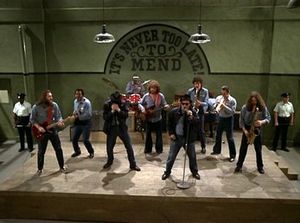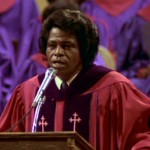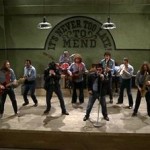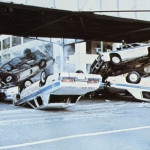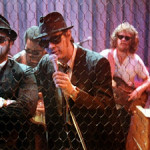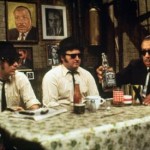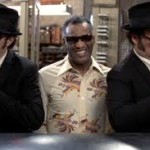It’s tempting to split this review into chunks, then file one in Action, one in Musicals, one in Comedy. The Blues Brothers all of these things and more, but most of all it’s a light hearted and highly destructive anarchic romp through Illinois state, punctuated by cartoonish violence and great music. Some will take greatest pleasure in the trashing of a truly absurd number of police cars (at the time it was a movie record), others in the plot and script (especially some great one-liners, delivered with very straight faces) and the sending up along the way of religion, Nazis, C&W, police driving and women, among others. The scattergun satire will annoy many but in the context of the movie you would be hard pressed to take genuine offence.
But for me the music is what makes the Blues Brothers memorable. Great versions of great songs, which is why people often rush out to buy the soundtrack: the Peter Gunn theme, Give Me Some Lovin’, Think, Minnie the Moocher, Everybody Needs Somebody to Love, Rawhide, Sweet Home Chicago and more, all great stuff – and there’s lots more in the movie but not on the soundtrack too!
Never before or since have the likes of James Brown, Cab Calloway, Ray Charles, Aretha Franklin, Chaka Khan, John Lee Hooker and Pinetop Perkins been assembled simply to play cameos as their own alter egos and perform sublime blues, soul and gospel along the way… and this is without the utterly sublime Blues Brothers Band, featuring Willie Hall, Tom “Bones” Malone, “Blue” Lou Marini, Alan “Mr Fabulous” Reuben, Steve Cropper, Donald “Duck” Dunn, Matt “Guitar” Murphy and Murphy Dunne – all hugely capable performers in their own right, as backing for John Belushi and Dan Ackroyd’s double act. This is the blues equivalent of Amadeus – no words of praise I can dream of can ever do justice to the music herein.
Not only were great musicians persuaded to ham it up and play fantastic music, a fair number of other well-known faces came along for the ride with cameos: Frank Oz, Steven Spielberg, Carrie Fisher, Twiggy, John Candy, Peewee Herman and more. All relatively light on plot (the boys raising money to save the Catholic orphans’ home in which they were raised by a nun (“the penguin”), but in a sense that is only a story on which to hang the chases, the characters and the music.
So in short, this is a hugely enjoyable star-studded fun action movie with great music. For all these pleasures we must thank director John Landis, renowned also for many more cherished pictures, for sticking to his guns and preventing the studio get their grubby mitts on the movie, in spite of it going several times over budget. I make no apology for repeating sections of the Wikipedia entry about the movie, since they are fascinating in their own right:
Origins
The characters, Jake and Elwood Blues, were created by Belushi and Aykroyd in performances on Saturday Night Live. The name “The Blues Brothers” was the idea of Howard Shore. The fictional back story and character sketches of blood brothers Jake and Elwood were developed by Aykroyd in collaboration with Ron Gwynne, who is credited as a story consultant for the film. As related in the liner notes of the band’s debut album, Briefcase Full of Blues, the brothers grew up in an orphanage, learned the blues from a janitor named Curtis and sealed their brotherhood by cutting their middle fingers with a steel string said to have come from the guitar of Elmore James.
Belushi had become a star in 1978 as a result of both the Blues Brothers’ musical success and his role in National Lampoon’s Animal House. At one point in that year he managed the triple feat of being the star of the week’s top-grossing film, top-rated television show and singing on the number-one single. When Aykroyd and Belushi decided they could make a Blues Brothers film, the bidding war was intense. Universal Studios narrowly beat Paramount Pictures for the project. John Landis, who had directed Belushi inAnimal House, was aboard as director.
However, the project had neither a budget nor a script. On the former issue, Universal head Lew Wasserman thought the film could be made for $12 million; the filmmakers wanted $20 million. It would be impossible to settle on a specific amount without a screenplay to review, and after Mitch Glazer declined to help him Aykroyd wrote one on his own.
He had never written a screenplay before, he admitted in the 1998 documentary, Stories Behind the Making of The Blues Brothers, or even read one, and he was unable to find a writing partner. Consequently, he put together a very descriptive volume that explained the characters’ origins and how the band members were recruited. His final draft was 324 pages, which was three times longer than a standard screenplay, written not in a standard screenplay format but more like free verse.[5] To soften the impact, Aykroyd made a joke of the thick script and had it bound with the cover of the Los Angeles Yellow Pages directory for when he turned it in to producer Robert K. Weiss. Landis was given the task of editing the script into a usable screenplay, which took him about two weeks.
The premise of the underlying plot, that a church-owned orphanage would have to pay a property tax bill, has been questioned—in Illinois, as in much of the rest of the world, property owned by religious groups and other not-for-profit organizations is tax-exempt. However, while the script was being written, a legislative proposal to tax such property was under consideration.
Principal photography
Filming began in July 1979, with the film’s budget still not settled. For the first month, things ran smoothly on and off the set. When Weiss saw the supposedly final $17.5 million budget, he reportedly joked “I think we’ve spent that much already.”
In the next month, the production began falling behind schedule. Much of the delay was due to Belushi’s partying and carousing. When not on the set he went out to familiar Chicago haunts of his such as Wrigley Field. People often recognized him and slipped him cocaine, a drug he was already using heavily on his own, hoping to use it with him. “Every blue-collar Joe wants his John Belushi story,” said Smokey Wendell, who was eventually hired to keep it away from the star. As a result of his late nights and drug and alcohol use, Belushi would often miss unit calls (the beginning of a production day) or go to his trailer after them and sleep, wasting hours of production time. One night, Aykroyd found him crashing on the sofa of a nearby house, where Belushi had already helped himself to food in the refrigerator.
Cocaine was already so prevalent on the set (like many other film productions of that era) that Aykroyd, who used far less than his partner, claims there was actually a section of the budget set aside for purchases of the drug during night shooting. The stars had a private bar, the Blues Club, built on the set, for themselves, crew and friends. Carrie Fisher, Aykroyd’s girlfriend at the time, says most of the bar’s staff doubled as dealers, procuring any drug patrons desired.
The original budget was quickly surpassed, and back in Los Angeles Wasserman grew increasingly frustrated. He was regularly confronting Ned Tanen, the executive in charge of production for Universal, in person over the costs. Sean Daniel, another studio executive, was not reassured when he came to Chicago and saw that the production had set up a special facility for the 70 cars used in the chase sequences. Filming there, which was supposed to have concluded in the middle of September, continued into late October.
On the set, Belushi’s drug use worsened. Fisher, who herself later struggled with cocaine addiction, says Landis told her to keep Belushi away from the drug. Wendell was hired to clear any from the places Belushi visited off-camera. Nevertheless, at one point Landis found him with what he described as a “mountain” of cocaine on a table in his trailer, which led to a tearful confrontation between them where Belushi admitted his addiction and feared it could eventually kill him.
After Aykroyd and Belushi’s wife Judy had a talk with him about his antics, the production returned to Los Angeles. Filming there again ran smoothly, until it came time to shoot the final sequence at the Hollywood Palladium. Just beforehand, Belushi fell off a borrowed skateboard and seriously injured his knee, making it unlikely he could go through with the scene, which required him to sing, dance and do cartwheels. Wasserman persuaded the city’s top orthopedic surgeon to postpone his weekend plans long enough to stop by and sufficiently anesthetize Belushi’s knee, and the scene was filmed as intended.
Locations
Much of the film was shot on location in and around Chicago between July and October 1979. Made with the cooperation of Mayor Jane M. Byrne, it is credited for putting Chicago on the map as a venue for filmmaking. Nearly 200 movies have been filmed in Chicago. “Chicago is one of the stars of the movie. We wrote it as a tribute,” Dan Aykroyd told the Chicago Sun-Times in an article written to mark the film’s 25th anniversary DVD release.
The first traffic stop was in Park Ridge, Illinois. The shopping mall car chase was filmed in the real, albeit abandoned, Dixie Square Mall in Harvey, Illinois. The bridge jump was filmed on an actual drawbridge, the 95th Street bridge over the Calumet River, on the southeast side of Chicago. The main entrance to Wrigley Field (and its sign reading “Save lives. Drive safely, prevent fires.”) makes a brief appearance when the “Illinois Nazis” visit it after Elwood falsely registers the ballpark’s location, 1060 West Addison, as his home address on his driver’s license. (Elwood’s Illinois driver’s license number is an almost-valid encoded number, with Dan Aykroyd’s own birth date embedded). The other chase scenes included Lower Wacker Drive, Lake Street and Richard J. Daley Center.
In the final car chase scene, the production actually dropped a Ford Pinto, representing the one driven by the “Illinois Nazis,” from a helicopter at an altitude of more than a mile—and had to gain a Special Airworthiness Certificate from the Federal Aviation Administration to do it. The FAA was concerned that the car could prove too aerodynamic in a high-altitude drop, and pose a threat to nearby buildings. The shot leading up to the car drop, where the “Illinois Nazis” drive off a freeway ramp, was shot in Milwaukee, Wisconsin near the Hoan Bridge on Interstate 794. The Lake Freeway (North) was a planned but not completed 6-lane freeway and I-794 contained an unfinished ramp that the Nazis drove off. Several Milwaukee skyscrapers are visible in the background as the Bluesmobile flips over, notably the U.S. Bank Center.
The “Palace Hotel Ballroom,” where the band performs its climactic concert, was at the time of filming a country club, but later became the South Shore Cultural Center, named after the Chicago neighborhood in which it is located. The interior concert scenes were filmed in the Hollywood Palladium.
The filming in downtown Chicago was conducted on Sundays during the summer of 1979, and much of the downtown was cordoned off from the public. Costs for filming the largest scene in the city’s history totaled $3.5 million. Permission was given after Belushi and Aykroyd offered to donate $50,000 to charity after filming. Although the Bluesmobile was allowed to be driven through the Daley Center lobby, special breakaway panes were temporarily substituted for the normal glass in the building. The speeding car caused $7,650 in damages to 35 granite pavers and a bronze air grill in the building. Interior shots of the elevator, staircase, and assessor’s office were all re-created in a film set for filming.
Bluesmobile
The film used 13 different cars bought at auction from the California Highway Patrol to depict the Bluesmobile, a retired 1974 Mount Prospect, Illinois Dodge Monaco patrol car. The vehicles were outfitted by the studio to do particular driving chores; some customized for speed and others for jumps, depending on the scene. For the large car chases, filmmakers purchased 60 police cars at $400 each, and most were destroyed at the completion of the filming More than 40 stunt drivers were hired and the crew kept a 24-hour body shop to repair cars.
For the scene when the Blues Brothers finally arrive at the Richard J. Daley Center, a mechanic took several months to rig the car to fall apart. At the time of the film’s release, it held the world record for the most cars destroyed in one film until it was surpassed by its own sequel.
Casting
Soul and R&B stars James Brown, Cab Calloway, Ray Charles, and Aretha Franklin were cast in speaking parts to support musical numbers built around them. This caused friction between Landis and Universal later in the production, as its costs far exceeded the original budget. Since none of them except Charles had had any hits in recent years, the studio wanted the director to replace them with, or add, performances by younger acts such as Rose Royce, whose “Car Wash” had made them disco stars after its use in the 1976 film of that name.
Other notable musicians in the case include Big Walter Horton, Pinetop Perkins, and John Lee Hooker, (who performed “Boom Boom” during the Maxwell Street scene). The members of The Blues Brothers band are notable for their musical accomplishments as well. Steve Cropper and Donald Dunn are architects of the Stax Records sound (Cropper’s guitar can be heard at the start of the Sam & Dave song “Soul Man“) and were half of Booker T. & the M.G.’s. Horn players Lou Marini, Tom Malone, and Alan Rubin had all played in Blood, Sweat & Tears and the Saturday Night Live band. Drummer Willie Hall had played in The Bar-Kays and backed Isaac Hayes. Matt Murphy is a veteran blues guitarist. As the band developed at Saturday Night Live, pianist Paul Shaffer was part of the act and was cast in the film. However, due to contractual obligations with SNL, he was unable to participate. So actor-musician Murphy Dunne (whose father, George Dunne, was the Cook County Board President) was hired to take his role.
Carrie Fisher, Kathleen Freeman, Henry Gibson, and John Candy were cast in non-musical supporting roles. The film is also notable for the number of cameo appearances by established celebrities and entertainment industry figures, including Steve Lawrence as a booking agent, Frank Oz as a corrections officer, Twiggy as a “chic lady” in a Jaguar convertible whom Elwood propositions at a gas station, Steven Spielberg as the Cook County Assessor’s clerk, John Landis as a state trooper in the mall chase, Paul Reubens (pre-Pee-wee Herman) as a waiter in the Chez Paul, Joe Walsh has a cameo as the first prisoner to jump up on a table in the final scene, and Chaka Khan is the soloist in James Brown’s choir. The character portrayed by Cab Calloway is named Curtis as an homage to Curtis Salgado, a Portland, Oregon blues musician who inspired Belushi while he was in Oregon filming Animal House.
Over 500 extras were used for the next to the last scene, the blockade on the building at Daley Center, including 200 National Guardsmen, 100 state and city police officers, and 15 horses.[16][20] Additionally, three Sherman tanks, three helicopters, and three fire engines were used.
Post-production
Landis’s difficulties continued even after principal photography was completed. The first cut of the film lasted two and a half hours, with an intermission. After one early screening, Wasserman demanded it be shortened, and 20 minutes were cut. The film’s final budget was $27.5 million ($76.6 million in modern dollars), $10 million over its original budget.[5]
Prospects for a successful release did not look good. Aykroyd and Belushi had left SNL at the end of the previous season, reducing their bankability. Belushi’s fame had taken a further hit after the commercial and critical failure of 1941 at the end of the year. One day after the editing was done, Wasserman invited Landis up to his office to speak with Ted Mann, head of the Mann Theatres chain, which dominated film exhibition in the Western United States. He told Landis that he would not book the film at any theaters in predominately white neighborhoods, such as Westwood. Not only did Mann not want black patrons going there to see the film, he surmised that white viewers were unlikely to see a film featuring older black musical stars. Ultimately The Blues Brothers got less than half the bookings nationwide for its initial release than a typical big-budget studio film of the era, which did not bode well for its success at the box office.
Box office
The Blues Brothers opened on June 20, 1980 with a release in 594 theaters. It took in $4,858,152, ranking second for that week (after The Empire Strikes Back) and 10th for the entire year. Over the years, it has retained a following through television and home video. The film in total grossed $57,229,890 domestically and $58,000,000 in foreign box offices for a total of $115,229,890. By genre, it is the ninth-highest grossing musical and the tenth-highest earner among comedy road movies. It ranks second, betweenWayne’s World and Wayne’s World 2 (which, coincidentally, also take place in the greater Chicago metropolitan area, in nearby Aurora, Illinois), among films adapted from Saturday Night Live sketches. Director Landis claimed that The Blues Brothers was also the first American film to gross more money overseas than it did in the United States.
Critical reception
Review aggregation website Rotten Tomatoes gives the film a score of 85% based on reviews from 45 critics.[22] It won the Golden Reel Award for Best Sound Editing and Sound Effects,[23] is 14th on Total Film magazine’s “List of the 50 Greatest Comedy Films of All Time” and is number 69 on Bravo’s “100 Funniest Movies”.
The Blues Brothers has been criticized for its simplistic plot and being overly reliant on car chases. Among the reviewers at the time of the film’s release who held that opinion was Roger Ebert of the Chicago Sun-Times. Ebert praised it for its energetic musical numbers and said that the car chases were “incredible”. In his review for The Washington Post, Gary Arnold criticized Landis engorging “the frail plot of The Blues Brothers with car chases and crack-ups, filmed with such avid, humorless starkness on the streets of Chicago that comic sensations are virtually obliterated”. Time magazine’s Richard Corliss wrote, “The Blues Brothers is a demolition symphony that works with the cold efficiency of a Moog synthesizer gone sadistic”.
Janet Maslin of The New York Times criticized the film for shortchanging viewers on more details about Jake and Elwood’s affinity for African-American culture. She also took director Landis to task for “distracting editing”, mentioning the Soul Food diner scene in which saxophonist Lou Marini’s head is out of shot as he dances on the counter. In the documentary, Stories Behind the Making of The Blues Brothers, Landis acknowledges the criticism, and Marini recalls the dismay he felt at seeing the completed film.
On the 30th anniversary, L’Osservatore Romano, the “semi-official” newspaper of the Holy See, wrote that the film is filled with positive symbolism and moral references that can be related to Catholicism. They went further stating, The Blues Brothers “is a memorable film, and, judging by the facts, a Catholic one.”
Cult-film status
The Blues Brothers has become a staple of late-night cinema, even slowly morphing into an audience participation show in its regular screenings at the Valhalla Cinema, in Melbourne, Australia. John Landis acknowledged the support of the cinema and the fans by a phone call he made to the cinema at the 10th anniversary screening, and later invited regular attendees to make cameo appearances in Blues Brothers 2000. The fans act as the members of the crowd during the performance of “Ghost Riders in the Sky“.
In August 2005, there was a 25th anniversary celebration for The Blues Brothers at Grauman’s Chinese Theatre in Los Angeles. Attendees included Landis, former Universal Studios executive Thom Mount, film editor George Folsey, Jr., and cast members James Brown, Henry Gibson, Charles Napier, Steve Cropper, and Stephen Bishop. It featured a press conference, a panel discussion where Dan Aykroyd joined via satellite, and a screening of the original theatrical version of the film. The panel discussion was broadcast directly to many other cinemas around the country.
The popularity of the film has also spread overseas as an inspiration. The film was an inspiration for Japanese companies Studio Hibari and Aniplex, which led to the creation of the manga and anime franchise Nerima Daikon Brothers, which contain heavy references to the film.

